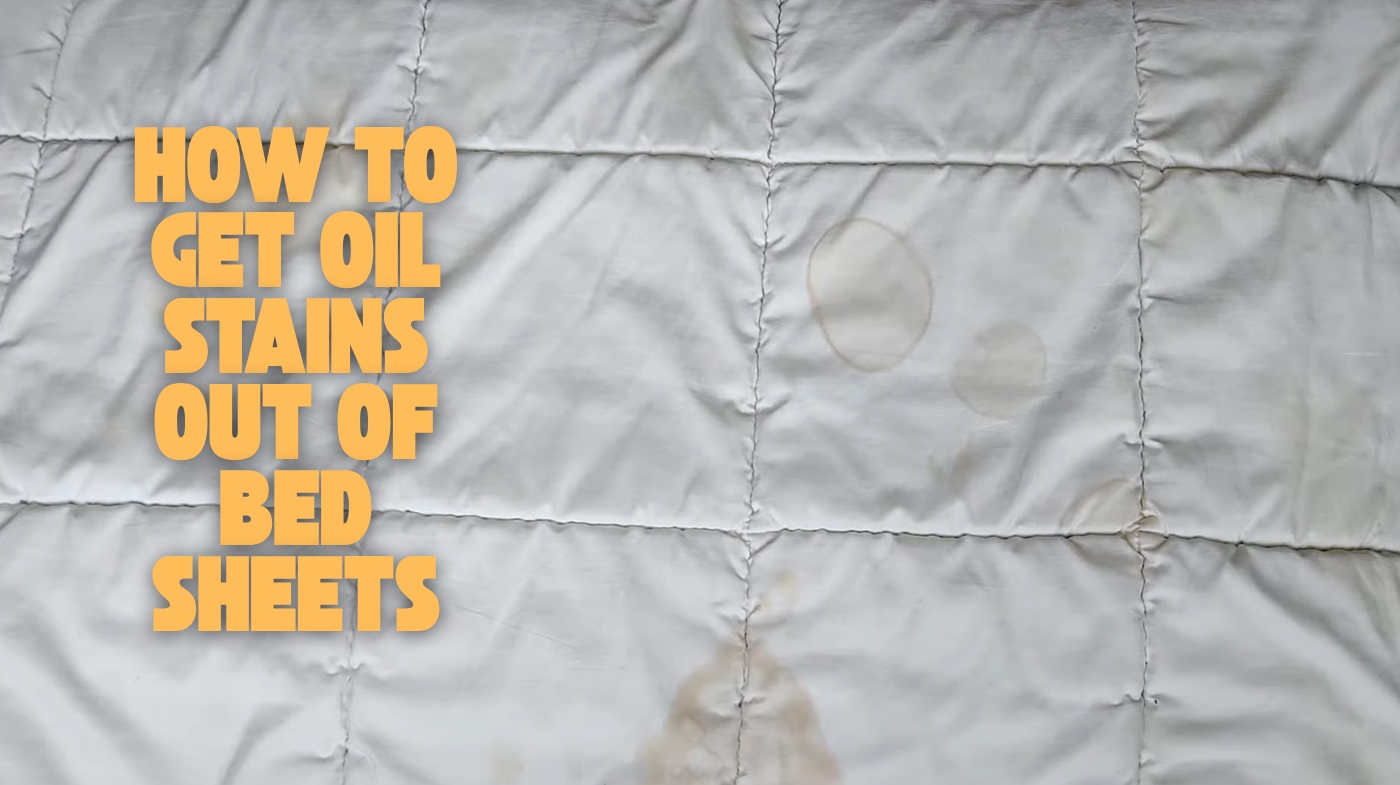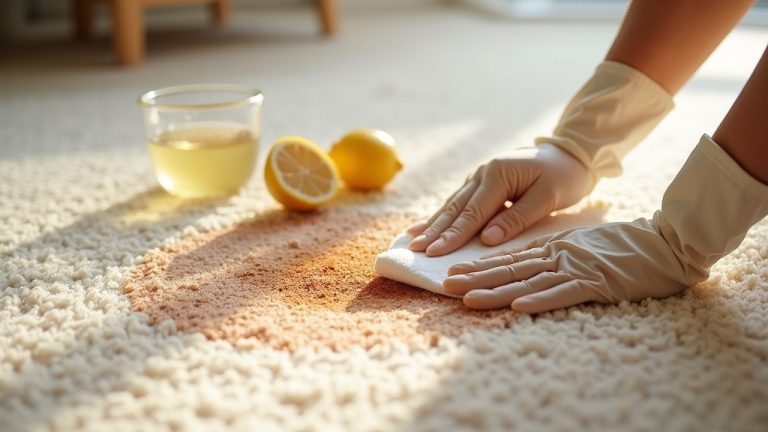How to Get Oil Stains Out of Bed Sheets? Effective Tips
To get oil stains out of bed sheets, first blot excess oil gently with a clean cloth without rubbing. Sprinkle baking soda or cornstarch to absorb the grease, then apply a stain remover or dish soap directly on the stain.
Let it sit for about 10 minutes, then wash sheets in cold or lukewarm water using a gentle detergent. Avoid hot water and bleach, which can set stains.
For stubborn marks or delicate fabrics, try specialized treatments to restore your sheets effectively—explore more for complete care tips.
Key Takeaways
- Blot excess oil gently with a clean cloth or paper towel immediately to prevent stain spreading.
- Apply enzyme-based stain remover or dish soap directly to the stain and let sit for about 10 minutes.
- Use absorbent powders like baking soda or cornstarch to draw out oil before washing.
- Wash sheets in cold or lukewarm water with detergent, avoiding hot water and bleach to prevent setting stains.
- Air dry sheets in a well-ventilated area; avoid dryers to prevent permanent oil stain setting.
Identifying Different Types of Oil Stains on Bed Sheets
When you’re trying to identify oil stains on your bed sheets, knowing their source helps you treat them effectively.
Body oil stains come from natural sebum mixed with sweat and antiperspirants, appearing as yellowish or dark marks mostly on pillowcases. These stains often require enzyme-based detergents for effective removal.
Identifying oil stain sources on bed sheets ensures effective treatment, with body oils often causing yellow or dark marks on pillowcases.
Cooking oil stains, from spills or oily hands, range from fresh greasy spots to dried grease, usually colorless or yellowish. Understanding the chemical nature of the stain can improve treatment, similar to how chemical compatibility matters in cleaning quartz surfaces.
Cosmetic and massage oils leave smoother, thinner stains that may include fragrances, penetrating deeply into fibers.
Mechanical oils, less common, produce dark, almost black stains with strong odors and need special removers.
Finally, synthetic oil residues from fabric softeners feel greasy but don’t change color, resulting from laundry overuse.
Immediate Actions to Take When Oil Stains Occur
When oil stains happen, start by blotting the excess with a clean cloth to prevent spreading. Next, apply an absorbent powder or a stain remover like dish soap to lift the grease.
Using enzymatic formulas can enhance the breakdown of stubborn organic residues. Acting quickly and carefully sets you up for easier removal later.
For fresh oil stains, applying Vanish Oxi Action Liquid directly onto the stain and gently massaging it into the fabric can significantly improve stain removal effectiveness (pre-treating fresh oil stains).
Blot Excess Oil
Although oil stains can quickly set into fabric, you can minimize damage by immediately blotting the excess oil with a clean, absorbent cloth or paper towel.
Act fast to prevent the stain from settling deeper into the fibers. Use gentle dabbing motions—never rub—to soak up as much oil as possible. Replace the cloth as it becomes saturated to keep absorbing effectively.
For fresh stains, it is also helpful to sprinkle absorbent powders like cornstarch or talcum powder to draw out excess oil before cleaning (immediate action).
Keep these tips in mind when blotting:
- Use white, lint-free cloths or paper towels to avoid color transfer.
- Dab gently, especially on delicate fabrics like silk or linen.
- Work in a well-lit area to spot all stained portions.
- Blot before oil dries to avoid pushing it deeper.
- Avoid colored or printed cloths that may stain your sheets.
Apply Stain Remover
Because oil stains can be stubborn, applying a stain remover designed specifically for oil is essential to break down the grease effectively. Use enzyme-based removers like Vanish Oxi Action Liquid. Apply enough to cover the stain fully, then gently rub it in with a soft tool.
Let it sit for about 10 minutes—no longer—to avoid fabric damage before washing. Since oil soaks into fabric fibers creating a barrier against water-based cleaners, it is crucial to treat the stain promptly to prevent it from becoming permanent.
For best results, immediately blot excess oil with a clean cloth to minimize penetration before applying stain remover, as immediate blotting helps prevent deeper staining.
| Step | Action |
|---|---|
| Choose Product | Enzyme-based stain remover |
| Application | Cover stain fully, rub gently |
| Wait Time | 10 minutes max |
| Wash | Use cold or lukewarm water |
Avoid bleach and hot water, which can set stains or damage fibers. Test products on a small area first.
Effective Pre-Treatment Methods for Oil Stains
When an oil stain hits your sheets, start by blotting the excess with a paper towel—don’t rub to avoid spreading it. This initial step is crucial as it helps prevent grease accumulation which can make stains harder to remove.
Next, apply a stain remover directly to the area, gently working it in to break down the oil. Because body oils tend to stick to bamboo fibers, proper pre-treatment is essential to prevent permanent stains.
Let the treatment sit briefly to penetrate before moving on to washing. Using the right techniques during this phase ensures effective stain removal and helps maintain fabric integrity.
Immediate Blotting Technique
To tackle oil stains effectively, you should start by immediately blotting the affected area with a clean, absorbent cloth or paper towel. Act fast to prevent the stain from setting into the fabric.
Follow these steps for best results:
- Use white paper towels or cotton cloths to avoid color transfer.
- Gently dab the stain without rubbing to prevent spreading.
- Replace blotting materials as they become saturated.
- Sprinkle baking soda, cornstarch, or baby powder to absorb residual oil.
- Perform blotting on a flat, stable surface in a well-lit area.
- Remember that fresh stains are easier to remove, so acting quickly is crucial.
- Always use cold water when rinsing stained fabric initially to prevent the stain from setting.
Stain Remover Application
Although immediate blotting helps, applying an effective stain remover is essential for breaking down oil molecules deeply embedded in your bed sheets. Use a specialized stain remover like Vanish Oxi Action Liquid, applying it generously to fully cover the stain.
Gently rub it in with your fingers or the applicator’s textured surface to aid penetration without damaging fibers. For the best results, you may consider using a specialized degreasing solvent designed to target fats and oils effectively.
Let it sit for about 10 minutes—long enough to break down oils but not so long it weakens fabric. For delicate sheets, opt for milder pre-treatments like a baking soda paste or diluted vinegar soak.
Always avoid harsh chemicals on sensitive fabrics. If you need to freshen up your sheets further, consider using steam cleaning techniques on a low setting as a safe and effective method.
After pre-treatment, wash the sheets in the hottest safe cycle to thoroughly remove loosened oil residues.
Best Washing Practices for Removing Oil From Bedding
Since oil stains can set quickly, you’ll want to start by blotting excess oil gently without rubbing to prevent spreading.
When washing your sheets, follow these best practices to remove oil effectively:
- Wash in the hottest water safe for your fabric (check labels).
- Use a heavy-duty detergent designed to break down grease and oil.
- Select a gentle or normal wash cycle to protect the fabric.
- Avoid fabric softeners as they can attract oil and reduce absorbency.
- If stains persist, repeat washing before drying.
- Incorporating natural cleaning agents can enhance stain removal while being safer for fabrics.
Additionally, using a liquid detergent is often more effective than powder for treating oil stains in linens.
Using Baking Soda and Vinegar for Enhanced Stain Removal
When you combine baking soda and vinegar, you create a powerful stain-fighting duo that lifts and breaks down oil more effectively than using either alone. Start by sprinkling baking soda on the stain to absorb grease for 30 minutes.
Remove excess, then apply a baking soda-vinegar paste to chemically break down oil. Let it sit before washing with detergent. Always air dry clothes post-treatment to avoid setting stains. Repeat if needed and air dry to avoid setting stains.
It is important to ensure proper ventilation during cleaning to avoid any potential overheating risks from chemical reactions.
| Step | Action |
|---|---|
| 1. Baking Soda | Absorbs grease; mild abrasive |
| 2. Vinegar | Acidic; breaks down oil molecules |
| 3. Paste + Detergent | Synergistic cleaning; lifts stains |
Laundry Stripping Techniques for Deep-Set Oil Stains
If your bed sheets have deep-set oil stains that resist regular washing, laundry stripping can provide a powerful solution. This method uses a hot water soak with a special mixture to break down and lift embedded oils. Here’s how you can do it effectively:
- Fill a tub with the hottest water safe for your fabric. Using biodegradable cleaners can further assist in breaking down the oil stains safely.
- Dissolve borax, washing soda, and laundry detergent in a 1:1:2 ratio.
- Submerge your sheets fully and stir occasionally for at least 4 hours.
- After soaking, rinse or run a wash cycle without detergent or softener.
- Air dry to avoid setting any remaining residue.
Special Care Tips for Bamboo and Delicate Fabrics
Although bamboo and other delicate fabrics require extra caution, you can effectively remove oil stains by using gentle methods tailored to their sensitivity.
Start by pre-soaking the sheets in a mixture of one part white vinegar to four parts cold water for 30 minutes. Adding vinegar not only helps break down oils but also eliminates bacteria that cause odors. Using mild, natural cleaning agents prevents damage that harsh chemicals can cause to delicate fibers.
For stubborn stains, add a splash of gentle, bleach-free detergent and extend the soak. Avoid hot water and harsh chemicals like bleach, which damage fibers and cause discoloration.
Use a soft baking soda paste or diluted detergent to gently treat stains, blotting instead of scrubbing. Always test cleaning solutions on a hidden area first.
Wash bamboo sheets on a gentle cycle with cold or lukewarm water, and avoid fabric softeners. Handle stains promptly to preserve fabric integrity and softness. Applying protective treatments can help maintain fabric quality and prevent oxidation-related damage.
How to Dry Bed Sheets After Removing Oil Stains?
Since heat can set any remaining oil stains permanently, you should avoid using a dryer immediately after washing your bed sheets. Instead, air dry them to let any residual oil break down naturally.
Follow these steps for best results:
- Hang sheets outdoors on a clothesline or drying rack in a well-ventilated area. This helps ensure the fabric dries evenly without the risk of setting stains.
- Lay delicate or specialty fabrics flat on a clean surface to prevent stretching.
- Avoid wringing sheets; gently shake out wrinkles before hanging.
- Use padded hangers or wide clips to avoid creases or marks.
- Ensure sheets are fully dry before storing to prevent mildew and odors.
If you must use a machine dryer, select the lowest heat or air-fluff setting and always check the fabric care label first.
Preventing Oil Stains and Maintaining Clean Sheets
To keep your bed sheets free from oil stains, you need to take proactive steps and maintain a consistent cleaning routine.
Use cotton-rich fabrics and protective mattress or pillow covers to minimize oil contact.
Opt for cotton-rich fabrics and protective covers to reduce oil stains on your bedding.
Avoid eating oily foods in bed and rotate sheets every 1-2 weeks to reduce buildup. Wash sheets weekly with liquid detergents designed for grease removal, using the warmest water safe for the fabric.
Add natural stain removers like baking soda or vinegar during washes. Air out sheets in sunlight to break down residual oils and inspect for stains after each wash, treating any immediately.
For delicate or persistent stains, consider professional cleaning. Regular washing also prevents bacterial buildup and odor development, which can worsen oil stains (frequent laundering).
Frequently Asked Questions
Can Oil Stains Cause Allergies or Skin Irritations?
Yes, oil stains can cause allergies and skin irritations. When oils linger on your bed sheets, they trap dust mites and microbes that trigger allergic reactions. These allergens can cause itchy skin, redness, rashes, and worsen eczema.
The oils also block pores, leading to irritation or folliculitis. To protect your skin, wash sheets regularly and avoid oily products before bed, reducing allergens and preventing flare-ups effectively.
Are There Eco-Friendly Products for Removing Oil Stains?
Sustainable stain solutions such as plant-based products, citrus degreasers, and coconut-derived surfactants offer safe, effective oil stain removal. They use natural enzymes, extracts, and gentle surfactants that won’t harm your fabric or the environment.
You’ll avoid harsh chemicals and volatile organic compounds, protecting your skin and waterways. Simply apply, let enzymes work, then wash as usual. These eco-friendly options clean thoroughly without compromising nature or your health.
How Do Professional Cleaners Treat Oil Stains on Bed Sheets?
Professionals start by blotting excess oil without rubbing to prevent spreading. Then, they gently scrape dried deposits before applying degreasers or liquid dish soap to penetrate the stain.
They use heavy-duty detergents and warm water, carefully following fabric care instructions. For tough stains, they might pre-soak or use enzyme-based cleaners and oxidizing agents.
They rinse thoroughly and air dry, avoiding heat that sets stains. Fabric type guides their precise treatment choices.
Can Essential Oils Leave Permanent Stains on Bedding?
Yes, essential oils can leave permanent stains on your bedding, especially if you don’t act quickly. Oils like German Chamomile and Yarrow have bright colors that penetrate fibers deeply, making stains tough to remove.
The fabric type matters too—delicate materials like silk stain more easily. To prevent permanent marks, blot excess oil immediately and pre-treat with a mild detergent before washing in the hottest safe water for your fabric.
Is It Safe to Use Dishwasher Detergent on Oil Stains?
You can use dishwasher detergent to pre-treat oil stains, but be cautious. It’s harsher than laundry detergents and might damage or fade fabrics, especially delicates or colored sheets. Always spot test first, rinse thoroughly, and wash immediately afterward.
For safer, more effective results, opt for liquid laundry detergents or enzyme-based stain removers designed for fabrics. Avoid repeated use to protect your sheets’ longevity and your skin from irritation.
Keep Your Sheets Spotless With Gentle and Effective Methods
Getting oil stains out of your bed sheets isn’t as tricky as it seems. Act quickly, treat stains with the right methods, and wash carefully—like peeling layers off an onion, each step reveals a cleaner, fresher sheet.
Use baking soda, vinegar, or laundry stripping for stubborn spots, and always handle delicate fabrics gently. Follow these tips, and you’ll keep your bedding spotless and comfortable, ready for a good night’s sleep every time.







